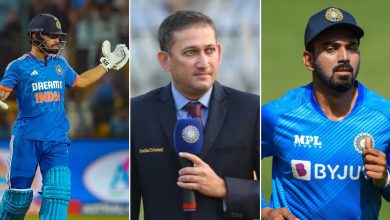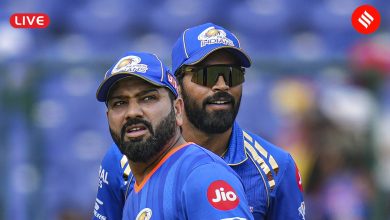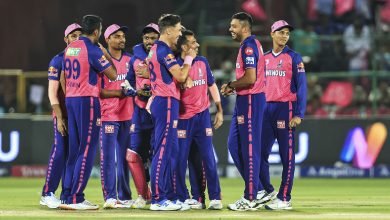Covid, murder, protests: As Indian wrestling endures setbacks, a Delhi akhara keeps churning out champions | Sport-others News

It’s nine in the morning at Delhi’s famed Chhatrasal akhara and trainees are lined up in the kitchen, armed with their casseroles and bowls after morning practice.On a large, wood-fuelled oven, stacks of rotis are being prepared, which disappear in no time. “It’s our lunchtime now and there’s no restriction on servings,” says a young pehalwan as he fills up a large bowl with raita, which, he says, will be his snack before the evening practice session. What might be an unusual lunch time for most is routine for these young men.For these 200 or so trainees, each day looks the same: wake up at 4.30am, warm-up, and spend nearly seven or eight hours training, taking breaks only to have meals. Same routine, seven days a week, 365 days a year.
Barely 5km from Delhi University’s North Campus, a student hub buzzing with life, the wrestling akhara inside the Chhatrasal Stadium is a world unto its own.
It also partly explains why, despite Indian wrestling enduring one setback after another, this place has kept churning out champions.
First, it was Covid that, like every other aspect of life, severely curtailed activities. Then, a murder on the stadium premises put undue attention on the academy, which ‘nearly shut’.
For the 200 or so trainees at Delhi’s Chhatrasal akhara, each day looks the same: wake up at 4.30am, warm-up, and spend nearly seven or eight hours training, taking breaks only to have meals. Same routine, seven days a week, 365 days a year. (EXPRESS PHOTO Abhinav Saha)
And just as it recovered from the twin blows, unprecedented crisis hit Indian wrestling this year after three of the country’s biggest wrestlers accused the federation president and six-time BJP MP of sexual harassment.
The long-drawn protests and the consequent dissolution of the Wrestling Federation of India had a knock-on effect on the entire sport as domestic activities came to a virtual standstill. Tournaments were put on hold, national camps dried up and on the international stage, India took a beating.
Nothing illustrated the sorry plight of Indian wrestlers more than the recently-concluded selection trials for next month’s Hangzhou Asian Games. The two-day event in July was marred injuries and poor, unpredictable form of some of the seasoned wrestlers.
The trials painted a bleak picture but one thing stood out: the superiority of the wrestlers from Chhatrasal. Wrestlers from this one academy reigned supreme in four out of the six men’s freestyle categories.
It’s home to one of the brightest young prospects in Indian wrestling, Aman Sehrawat, who competes in the 57kg weight class. And another World Championship, Asian Games and Paris Olympics medal hopeful, Deepak Punia, too is a product of this unique akhara.
“Baarish aandhi, tufan, kuch bhi ajaye training nahi rukti (come rain, wind or storm we never stop training),” says Lalit Kumar, a coach at the academy. “That is why we are different and better from the rest.”
Chhatrasal’s uniqueness also lies in its geography. Unlike most akharas, it isn’t located on the outskirts of a city or in the middle of a rural setup. (EXPRESS PHOTO Abhinav Saha)
It’s always been like this at Chhatrasal Stadium, where the akhara was started 1982 Asian Games champion Satpal Singh. The approach has helped them produce some of the finest wrestlers the country has seen.
The illustrious l includes the likes of Yogeshwar Dutt (London Olympics bronze), Bajrang Punia (Tokyo Games bronze), Ravi Dahiya (Tokyo Games silver) and the country’s most successful wrestler Sushil Kumar (Beijing Games bronze and London Games silver). Apart from KD Jadhav’s 1952 Helsinki Games bronze, all medals in Olympic men’s medals can be traced back to Chhatrasal.
And there is hope that the likes of Aman Sehrawat and Vishal Kaliraman, who qualified for the Asian Games in the same category as Bajrang Punia and hence is a stand, will carry forward the legacy.
‘Gundon ka adda’
Yet, it all very nearly unraveled when its biggest star Sushil Kumar was arrested for the alleged murder of a fellow wrestler that took place at Chhatrasal’s parking lot.
In October last year, a Delhi court framed charges of kidnapping, voluntarily causing hurt in committing robbery, wrongful restraint, robbery, robbery or dacoity with an attempt to cause death or grievous hurt and criminal intimidation against Sushil and his associates.
“People started calling our akhara a gundon ka adda (a den for criminals). A lot of kids left the akhara and many parents were reluctant to send their kids here. We had police investigators walking in every minute and it was very difficult to even function. To be honest, we were on the verge of shutting down,” recalls Lalit.
Just then, the Tokyo Olympics took place and Ravi Dahiya’s silver medal reignited the spirits of the young wrestlers, who found a new hero. “His medal saved Chhatrasal. Those kids who left returned and the focus was back on just training,” says Lalit.
Barely 5km from Delhi University’s North Campus, the wrestling akhara inside the Chhatrasal Stadium is a world unto its own. (EXPRESS PHOTO Abhinav Saha)
But despite the commotion, training never stopped. “The real secret of our academy is discipline,” says Lalit.
Even during peak Covid when a lot of residential academies sent their trainees back home, the practice continued at Chhatrasal with social dancing, whatever little of it could be managed in a contact sport like wrestling.
‘Walls are our border’
Chhatrasal’s uniqueness also lies in its geography. Unlike most akharas, it isn’t located on the outskirts of a city or in the middle of a rural setup. The stadium wall, in fact, separates the akhara from the countless cafes, eating joints, and movie halls of the Model Town area. All of it, though, is all strictly out of bounds for the wrestlers.
“Stadium ki diwar humare liye border hai. (The stadium’s walls are a border for us). We don’t even think of crossing it. We know that if we go out we will get dracted and all our training will be ruined. Also if we get caught, we will get the boot anyway. We like our lifestyle here, we don’t want to be like the other youngsters,” says 21-year-old Abhay Raj.
The walls of Chhatrasal not only restrict the movement of personnel but also seem to filter information. Most wrestlers at the academy have little or no Idea about the wrestlers’ protest. The only information they seek through news media is trials and competition dates.
“We have no clue what’s happening beyond the walls of our akhara and neither do we pay any attention. Phone usage is limited for filling out applications and other work. We consciously stay away from any media content. All our conversions are just about training and workout,” says wrestler Anil Sharma.
Vishal Kaliraman, who was considering moving the Supreme Court so that he could compete in the Asian Games instead of Bajrang, says he’s been off social media for months now.
“Focus rehne ka yahi tareeka hai. (That’s the only way you can remain focussed). We have no idea what’s happening around us. Training, rest and recovery are all that will run on my mind till the Asian Games,” says Vishal, who feels the commotion around wrestling hasn’t affected his training at all.
Commonwealth Champion Deepak Punia, who secured an Asian Games berth in the 86kg category, echoed Kaliraman’s views when asked about the protests and developments surrounding it. But the World Championship medall admits he has been durbed the Ad-hoc committee’s uncertain trial dates.
“We haven’t stopped training for a single day but then it’s hard to plan anything. I had to cancel my overseas training plans thrice because the trial dates kept changing. We are professional wrestlers and plan our training and weight-cut program according to major competitions. We can’t be constantly worried about trials. There needs to be a system in place,” says Punia who has three Asian Games medals already.
The system, the ‘jugaad’ and the ‘dose’
Back to Chhatrasal’s system which is fuelled discipline and some “jugaad” (ingenuity) as well. While there’s mud akhara and mat training hall near the entrance gate of the stadium the real business takes place in the basement parking lot. It is almost like Batman’s cave. It would be a little unfair to call it just a parking lot since it serves as an elite training centre for the country’s best grapplers.
A mud akhara with football dugout seats, a huge hall with three wrestling mats and a state-of-the-art gym are all tucked into the basement. (EXPRESS PHOTO Abhinav Saha)
A mud akhara with football dugout seats, a huge hall with three wrestling mats and a state-of-the-art gym are all tucked into the basement. “We’ve had this system for a long time. We needed an indoor training facility so we decided to use the parking space and the adminration supported our plans,” says coach Lalit.
Good facilities, good coaches and discipline sounds like a perfect recipe for success but there’s a little trade secret that the trainees reveal that they feel is the “real secret” for Chhatrasal’s success.
“Danda (stick). If you don’t wake up yourself at 4:30 am rest assured the coaches will hit you with the stick. You wanted to know why Chhatrasal trainees are so good right? That’s the secret. We actually need it. Tell me will I wake so early if the coaches came and knocked at my door politely and waited for me?” says a young trainee at their resting quarters as the rest of the roommates burst into laughter.
The pehalwans assured that the danda is used sparingly in a very mild manner. “They don’t hit us. It’s just a gentle pat on the back sometimes and that’s enough. We have so much fear and reverence for our coaches so that’s enough for us to pull ourselves up,” says a trainee.
Coach Arun Kumar, who is also Ravi’s sparring partner, confirms the danda theory with a smile. “From national champions to Olympic medalls, everyone at Chhatrasal has at some point received a little ‘dose’.”







